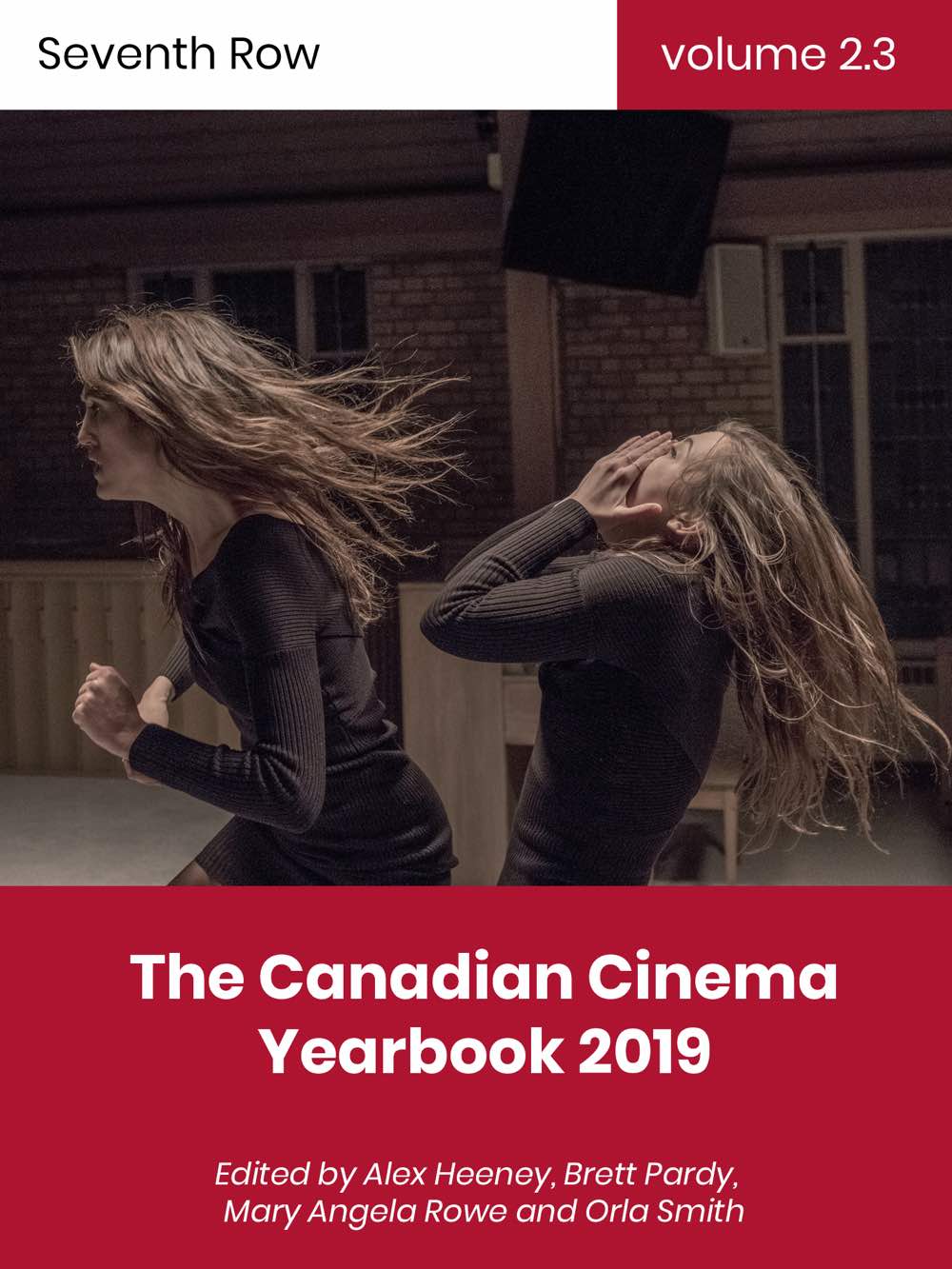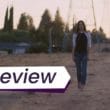Zoe Leigh Hopkins, director of the feature film Run Woman Run, talks about telling a different kind of coming-of-age-in-your-thirties story, filming in her home of Six Nations, and more.
Read our review of the film Run Woman Run here.
Listen to the podcast on Zoe Leigh Hopkins’s Run Woman Run and telling a thirtysomething coming-of-age story through an Indigenous lens.
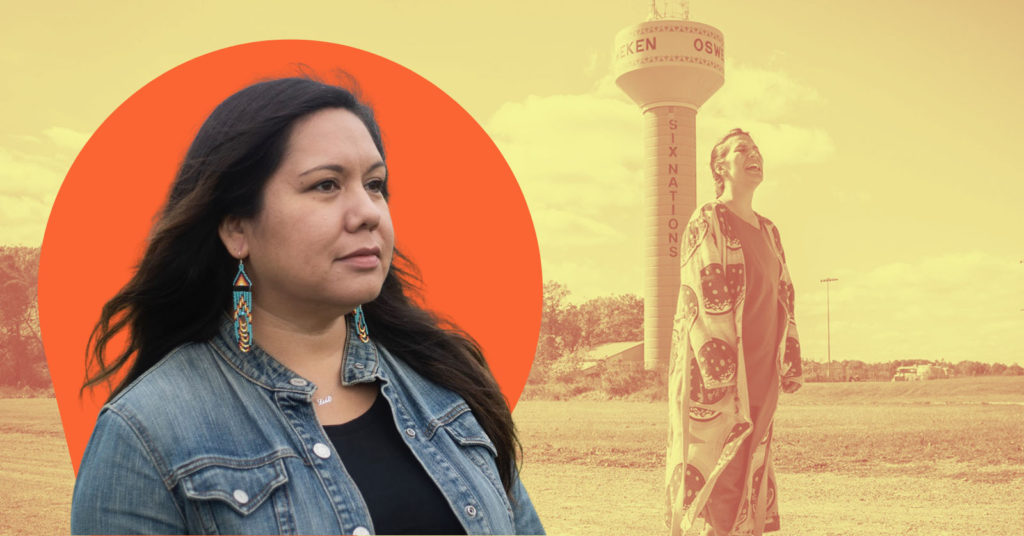
Discover one film you didn’t know you needed:
Not in the zeitgeist. Not pushed by streamers.
But still easy to find — and worth sitting with.
And a guide to help you do just that.
With Run Woman Run, her second feature film, Zoe Leigh Hopkins tells a story that’s rarely been seen on screen before. It’s a film about coming of age in your thirties, but through the perspective of an Indigenous woman. It seriously addresses the intergenerational trauma that Indigenous people live with, but it’s a feel-good film that’s ultimately funny and uplifting. It’s about a woman who has a child, a job, and romantic prospects, but none of those things are the centre of her story or eclipsing everything else. (We spoke about this at length on a recent podcast episode about the film.)
Hopkins’s protagonist is Beck (a fantastic Dakota Ray Hebert), who lives in Six Nations, the largest First Nations reserve in the state of Canada, and Hopkins’s father’s community (Hopkins currently lives there herself). Beck lives in her family home with her father, Len (Lorne Cardinal), high-achieving sister, Jess (Jayli Wolf), and prepubescent son, Eric (Sladen Peltier) whom she’s co-parenting with her ex. It’s a loving household, but one still healing from the suicide of their matriarch several years prior, at which point Beck started coasting through life. While before, she was on top of things and well into the process of learning the Mohawk language, she’s now a slacker and a sugar addict. Her depression means she’s doing the bare minimum to get through life while taking care of the loved ones around her, particularly her son, but in the process, caring for herself becomes her last priority.
That is, until she passes out unexpectedly and gets a diagnosis of type 2 diabetes. With Beck at her lowest (or close to it), Run Woman Run becomes a film about a woman realising she needs to take back control of her life. That means exercising, eating healthily, finding purpose, and more importantly, caring about herself enough to believe she deserves any of these things. But it’s also a film about how difficult it is to get to that place. Beck spends most of Run Woman Run floundering while her family urges her to take care of herself. Even after a medical emergency, she can’t find the motivation to take herself seriously for her own sake. Run Woman Run is about the journey toward the beginning of the healing process, which can be just as hard of a hill to climb than the ongoing healing itself.
Hopkins’s film is so successful not just because of how much we’re rooting for the witty, lost Beck, but also because of how rich an ensemble of characters Hopkins creates around Beck. In so many films, we follow a protagonist whose life is unrealistically simple, because crafting a full life for a character is a tricky task for any screenwriter. While film characters live in a parallel universe without jobs or friends or parents to deal with, real people have to juggle multiple relationships at once, whether romantic, platonic, or familial, while also working enough to pay the rent, and attempting to build some free time for themselves and their own hobbies on the side. In Hopkins’s words, “How can you be all these things to all of these people? It’s exhausting.”
Beck’s life is full in a way we rarely see depicted on screen. She’s managing her own relationship to each member of her family, as well as liaising with her ex as they split their time with Eric, worrying about her father’s failing romance with his new girlfriend, working for her father as a car mechanic, and considering going back to Mohawk language lessons under her sister’s tutelage. When a potential romantic interest arrives, Jon (Braeden Clarke), he doesn’t become the film’s focus; their budding relationship is just another example of the multitude of relationships and experiences available to Beck in her community, once she comes out of her cocoon and starts living life again.
Then there’s the spirit of famed Indigenous runner Tom Longboat, played by the incredibly charismatic Asivak Koostachin, who comes to visit Beck to encourage her to run. Not only does Koostachin’s charm and wit add some comedic relief, his presence as the historic Tom Longboat serves to connect Beck’s present day struggles to the past struggles of Indigenous Peoples. Longboat was a residential “school” survivor. While Beck laments that she shouldn’t complain about her problems, because they’re nothing compared to his, we understand that it’s all related intergenerational trauma, from Beck’s mom’s suicide to Beck’s own depression.
I spoke with writer-director Zoe Leigh Hopkins about how she approached making her film Run Woman Run, writing Beck and her surrounding community, balancing serious themes with a light tone, and how the community support in Six Nations was invaluable to a low-budget film project.
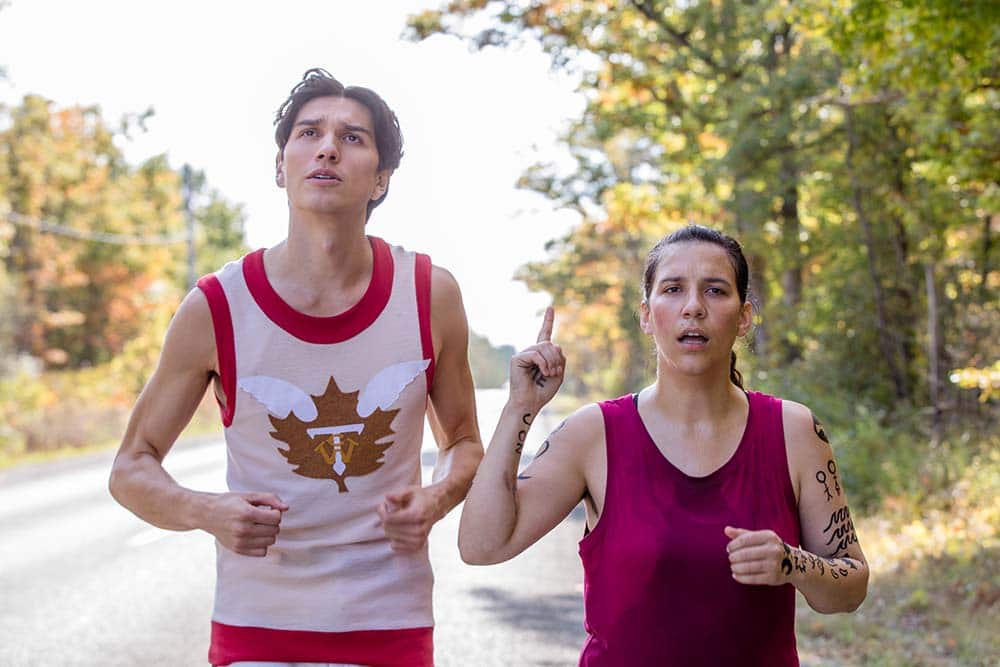
Seventh Row (7R): Could you tell me a bit about the origins of the film Run Woman Run?
Zoe Leigh Hopkins: I was standing one day at the end of the Vancouver Marathon, waiting for a friend to cross the finish line. I had no idea that I would be standing there crying the whole time, watching all these strangers undergo these wonderful, transformative journeys. Not knowing any of them, I was just so moved by seeing them run into the arms of their families, or collapse and cry by themselves. That’s sort of where the genesis of [Run Woman Run] came from, seeing from my friend just how transformative it can be to take on a huge new project, whether it’s running, learning your language, or just doing something that changes your life and shakes things up. I really wanted to make a story about how you can get back into your life.
I always thought that runners looked like a certain kind of person and was amazed that lots of different kinds of people were finishing that marathon. It just made it sort of seem possible. I was really interested in telling a story about somebody that wouldn’t normally imagine doing something like that.
7R: Run Woman Run is tackling a lot of complex things like grief and trauma, but it’s also funny and lovely and heart-warming. How did you approach the tone of the film?
Zoe Leigh Hopkins: I gravitate toward stories that feel good at their core. You walk out feeling good: you’ve laughed, you’ve been entertained, and you’ve engaged with a human story. However, I kind of like those stories that cover the full range: maybe you’ll have cried, but you’ve also laughed. [I like] when you’ve seen parts of yourself in there, [which is sometimes] in the hard things. If you recognise grief, that’s something that we’ve all grappled with. You can really reach people by talking about those things.
Even in those darkest moments, there’s often laughter. I’ve probably laughed a lot at all the funerals I’ve been to. Which is such a weird emotion. Since you’re all together, someone’s gonna say something funny, or something weird is gonna happen, and you’re just gonna laugh. I really love those moments where you’re just feeling the full human experience all in one go. I tried to do that with this movie.
7R: It must be a tough prospect to approach talking about something like suicide in Run Woman Run without the film itself becoming this traumatic thing.
Zoe Leigh Hopkins: It’s also something that the characters tell me, as I’m writing. I think there was one day when I was working on one of Beck’s scenes and I realised, oh gosh, her mom died! I knew for some time that her mom died, but I didn’t know exactly how. And then one day, I just had a sudden realisation that her mom took her own life.
That really felt right for the story. It felt right for the weight that I wanted her to carry, what she had to come out of. When I think about people in my life who’ve taken their lives, or the people who are really the closest to them, I’m amazed by how much people carry around, and yet still accomplish great things. This is the feeling that I sit with when I watch Beck doing her marathon, and when she’s in her hardest mile. Those are the things that she’s thinking about and remembering. And that’s what I’m trying to honour.
So many of us are carrying so much. Especially in the past couple of years, we’ve all had to carry more than where we were used to. And yet, we’re still going to work or school, or parenting, doing all these great projects. I’m just inspired by humans, really.
7R: Could you tell me a bit about your writing process on Run Woman Run? There are so many characters in the film, and it’s such a rich ensemble.
Zoe Leigh Hopkins: When I’m really in the groove, I’m just dictating what the characters are saying in my head. It sounds so hokey to say, and I’m embarrassed for myself as I’m saying this out loud, but sometimes, it really feels like I’m just a conduit for a story that’s coming through me.
The ghost of Tom Longboat is in this story; I really feel like I didn’t make that happen. He just appeared in my head one day, and Beck was in the scene running and then suddenly, I’m just writing down that the ghost of Tom Longboat is with her. And I was so surprised. It was just meant to be her doing this run. And then, one day, I imagined that Tom Longboat was saying to me in my head, “You’re writing a story about running in the Six Nations, and I’m not in it?” So then, I decided, of course he’s in it! He’s a real-life sports hero. He’s a revered legend, especially around here, but also across Canada.
Sometimes, it’s definitely just work, figuring out the plot, writing stuff down, reordering things, and whatnot. I feel like I reinvent my system for how to do that every single time. The work part is really boring to talk about, but the fun part is when it just comes.
7R: Tom is interesting, because even at Beck’s lowest, when she’s been left by everyone in her life, Tom’s presence means she’s never totally alone.
Zoe Leigh Hopkins: I felt like Beck, in her darkest hour, needed to be alone, and guided by her own inner voice, which sometimes comes through Tom. The way he goads her, inspires, and encourages her, those are all things that we do to ourselves. When we’re alone, we put ourselves down, or we try to pick ourselves up, and our inner voice can be such help. And a hindrance, too, sometimes.
7R: When you were writing Beck, how did you think about what kind of a person you wanted your heroine to be?
Zoe Leigh Hopkins: I like to think of this film as an anti-rom-com. I wanted Beck to be somebody who worked really hard to improve herself and fix her life — not for the love of a man, and not to get beautiful and have a hot body or something. I wanted her to transform her life, and to be her best self. And try to be a better daughter, sister, and mum. When things are especially heavy, you kind of just put one foot in front of the other, and that’s the best you can do. But if you get stuck in that because grief is weighing you down, years can go by, and then you wonder what happened to all those dreams you had.
I wanted it to be about her finding that again, finding that spark. And so, it couldn’t ever be about, oh, here’s this cute guy that pops up, and now I’m going to change my life for him. I think we’ve seen a lot of that. Those are fun fantasy stories.
I wanted her to be kind of a slacker and somebody we all kind of relate to. We know it’s easier to lay on the couch and watch cartoons and eat a bowl of chips than it is to work out or do homework or whatever. I think everyone can relate to that total disappearance of motivation. I wanted her to be relatable and funny, but also inspiring.
7R: Can you tell me a bit about the community where Run Woman Run is set, and your connection to it? Why was that setting important to the film?
Zoe Leigh Hopkins: The film is set in Six Nations, which is where I live. This is my father’s community. I didn’t grow up here, but I live here now. I’m raising my son here, and we live next door to my dad.
Since moving back here, I learned to speak Mohawk and taught online for several years. The film is set here, just because I wanted to set it in one of my home communities.
I’m from Bella Bella [British Columbia] on my mom’s side; that’s where I was born. I’ve made a film on the west coast called Kayak to Klemtu, and I always thought that film was my love story to the west coast. And then it felt fair that I should make a film for this community.
Now I feel like I can do whatever I want. I have made a love story to each of my communities and to each of my peoples.
7R: What was it like to bring the mechanisms of a film crew into your community for Run Woman Run?
Zoe Leigh Hopkins: Here in Six Nations, there is a huge community, like 13,000 people live here. It takes half an hour to drive from one end to the other. It’s a little bit different from filming in Bella Bella, which is 1,500 people, and you can walk from one end to the other in ten minutes.
I don’t know the majority of people here, because there’s just so many. But it made an impression on the people in my family, for sure. My family catered for us, and we did get in the way sometimes, but it’s really lovely to have the support of the community. I asked for permission to film from the Band Council, and I asked for permission from the Tom Longboat family to represent him in the film in this way, because it’s not about him. And it’s not meant to be a biographical depiction of him. So, with their blessing, I did that.
When you film a movie in your community, you get things that you can’t pay for anywhere else. If nobody scheduled a car to be in the movie for tomorrow, I can just get on the phone and ask my uncle if I can borrow his car tomorrow. For stuff like that, we can just call somebody up. Corn soup is a traditional dish here. The production designer is a Métis guy, not a Mohawk guy, and so when corn soup was written in the script, he didn’t know, and I didn’t know that he didn’t know. How would you know that somebody doesn’t know until the wrong corn soup shows up on set? I saw it, and I was like, what is that?! [But then] I know who to call and be like, “I’m coming to get five bowls of corn soup,” and send somebody to get it.
7R: If you’re working on such a low budget, being somewhere where the people around you care about you making the film must help immensely.
Zoe Leigh Hopkins: Yeah. We took over a neighbour’s house for probably a month. That was Beck’s house in the film. I didn’t really know her very well at all before filming the movie. She said to me, “I only did this because I really wanted to help somebody in our community make their dream come true.” I thought that was so beautiful, to support and love your community like that. I’m just here standing on the shoulders of all of these people who supported me. It’s really an incredible feeling.
7R: One thing I really love about Run Woman Run is that there’s such a rich ensemble cast around Beck. There’s so much going on in her life, and you balance it all so well. How did you approach writing a community around Beck?
Zoe Leigh Hopkins: It was difficult. That’s one of the things that I struggled with in the writing and in the editing room — how to keep all of these threads, because they’re all so important. The first draft of the film was two and a half hours long. I had to figure out what’s got to go and what can stay or be moved around. It was such a different experience from editing my first feature film, because that one was a literal and geographical journey from one point in the world to another point in the world. There was very little moving around that you could do with the scenes, because they’re on an actual quest.
[Run Woman Run] is more of an internal journey. There was so much room and possibility to move things around, and I was sort of surprised by that. I feel like the story echoes some parts of myself, though I don’t share any of the story points with Beck, other than when I learned my language. But my mom is alive, although I do have a son and I am a de facto single mom, I’m not a runner. Lots of things don’t echo my life here. But the fact that she has all these balls in the air, I think that is relatable to my life, and a lot of women’s, especially moms’, lives. How can you be all these things to all of these people? It’s exhausting.
I think the pandemic has really highlighted that, not just the work of parents, but the work of moms, especially. What the heck do we do? We’re expected to work like we don’t have kids, and we’re supposed to parent as if we don’t have jobs. It’s really hard. I hope that when people try to see the threads that are attached to Beck, that it relates to some part of their life. She has a lot going on. And this movie has a lot going on. That’s because, like in life, we all have a lot going on. It was hard to [reduce] that down into just a couple of threads because I really wanted to tell it all.
7R: You talked about the film as an anti-rom-com before, and how it’s not about her changing herself for a man. But you did include a romantic subplot. I was really happy to see that, even though you included that, it wasn’t the centre of the film. It was just another thing in Beck’s life. How did you think about why and how to include that subplot?
Zoe Leigh Hopkins: I really liked the idea of introducing the promise of romance without delivering a love story. To show we’re still lovable people, even when we’re at our worst. I really think that Beck is so lovable. She’s hilarious and a good person at heart.
I think that we put a lot of pressure on ourselves, as women, to be attractive. Social media and other media makes you think that you must be one way in order to be desirable. However, Beck is just herself. I really wanted that to be attractive to somebody. That would be my true love story, a rom-com where somebody never changes, they’re just loved.
7R: I really like the moment in the film where Beck is eating a giant bowl of crisps, and her love interest Jon knocks on her door. I kind of expected her to panic and hide the crisps, because I feel like I’ve seen that sort of thing happen in countless other films. But she just goes out and continues eating them while she greets him.
Zoe Leigh Hopkins: I really love those moments, like when she suddenly ends up on a date. They meet up, and she’s like, I’ll just get in your car. I made a point to show that she doesn’t look in the mirror to fix her hair, or put on lipstick, or try to impress. She is just unapologetically herself, which I admire about her character. Wouldn’t it be great if we all never worried about that stuff?
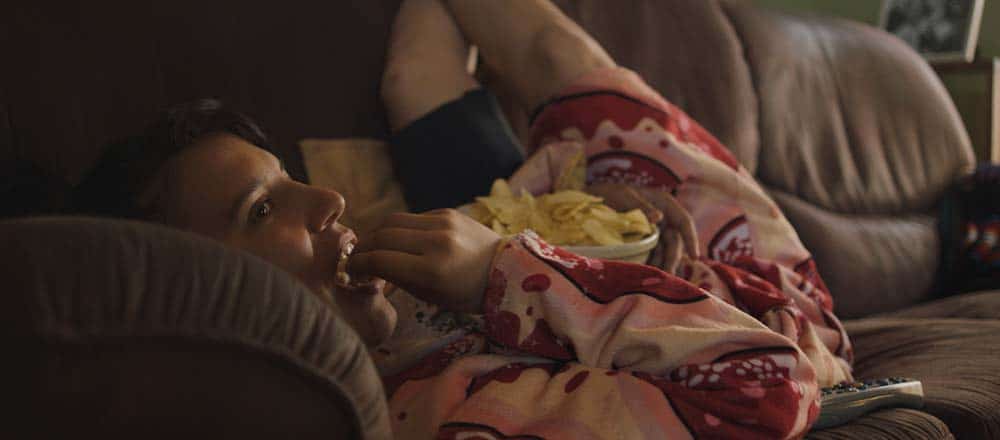
7R: Could you tell me about the process of casting your amazing ensemble of actors for Run Woman Run?
Zoe Leigh Hopkins: I loved finding this cast. I’m so in awe of all their performances. Working in the indie film world, where we don’t have a lot of money, you have to move fast. The one thing I could rely on every day was that the cast would nail it, every time. That was true every day, cracking us up and just being beautiful and magical and crying on the spot. It was incredible to watch them work, and watch them work together.
Dakota Ray Hebert, who plays Beck, is such a talent. This was her first film; she’s actually a comedian, and that’s how we found her. We just did a search for Indigenous comedians, and she came up. We found some of her stand-up. She was hilarious. I loved her voice. She has such a distinctive, weird voice.
I reached out to her on Facebook. I told her I saw her stand-up and I thought she was really funny, and asked her if she would like to audition. She read, and we were just all so excited and relieved and pleased, because there was a time where it was almost going to have to be me who had to play her. Which would have meant the rest of the cast would fall apart, because we couldn’t cast the lovely Braeden Clarke to play her love interest. I’m almost old enough to be his mom. That would have been weird. And we wondered whether Lorne Cardinal is old enough to be my dad. So we decided to keep looking. It was a relief to find her, so I only had to wear one hat.
She’s such a find, and so was Asivak Koostachin, who plays the ghost of Tom Longboat. He’s really going to be a rising star this year with some of the stuff that he’s working on.
7R: Seventh Row’s Editor-in-Chief Alex Heeney has seen a bunch of things that he’s in, and she’s always telling me he’s a star. Then, I finally saw him in your film, and I totally got it. He’s so charismatic.
Zoe Leigh Hopkins: He’s got oodles of charisma, incredible talent, and a wide range. He’s such a great age and clearly handsome, which helps. He really brought such a magical element to Tom that was so surprising and delightful. He just gave the role this sort of old soul vibe. And Asivak is kind of like that in real life. You meet him, and you’re like, who is this guy? He’s definitely an old soul.
He told me a nice story about his approach to the Tom Longboat character. Although Tom is a real-life sports hero, there’s very few archival pictures out there on the internet. But he looked at all of them and found one. Looking at his eyes, and this little smile on his face, he said, “That’s a cheeky little smile.” That one smile and that one look in his eye from that one photo informed his entire approach to the character. That’s where he got such a cheeky approach to it. I was like, that’s it! This is so beautiful.
7R: I know that you worked on a very small budget for the film Run Woman Run, and I found what you achieved so impressive: to juggle so many characters in a dialogue-heavy film, and it looks great. How did you work with and around your budget, resources, and time constraints?
Zoe Leigh Hopkins: I think a lot of that comes down to filming in the community and not building sets. Everything that you see in the film is an actual location. We moved things around and put up new curtains or redecorated a little bit, but for the most part, what you see is what you get. We happened to have lots of great little locations here, like that drive-thru coffee shop.
7R: And the painting on the wall of the language school?
Zoe Leigh Hopkins: Yeah, the building that that painting is on served us for so many locations. That was a huge saving, having the generosity of our community to be able to film in that building, and around that building for so many days. So many scenes happened there. We built the hospital room in there, the language school was in there, the 10k race was there, part of the date night was in there. The running scenes, where they’re practising on the track, is there. When the kids are practicing karate, that happens there. We were there for a good solid week.
7R: Wow, that’s impressive. And what about shooting the running scene at the end of the film Run Woman Run? It’s such a weighty scene, and you find lots of different ways to shoot the running to make it feel like a real physical and emotional journey.
Zoe Leigh Hopkins: From making Kayak to Klemtu, my first film, I knew that we [had to] save money while shooting to make sure that we could go back after we had done an edit of the film, to just shoot more kayaking. We knew that, on this journey, we would need to pepper it with the concept of kayaking. When you’re shooting with your main unit, you’re so concentrated on doing your page count and getting your dialogue down. While getting all those scenes done, the concept of the journey kind of disappears. We saved money to be able to go back and do that and have an edit done to know which days in the story those beats had to happen.
I knew I wanted to do that again for this film, but with running. We did save money to be able to go and do some reshoots; we call them reshoots, but they were just shoots of just running. We needed to know [from the edit] where she’s at in her emotional journey, and for her physical journey, we needed to know what outfit she has to be wearing, what it needs to look like in the world, how we need to shoot it, what kind of face she needs to have on…
By the time that we had a cut done to be able to know where we needed more running, it was December. We had done our main photography in September, October, but by this time in Canada, it’s snowing, there’s no more leaves on the trees, the world does not look the same at all. To get more running, we scoured Google Maps and satellite view to look for a place south of us that might have similar vegetation, and still have leaves on the trees in mid-to-late December. We scouted three states and decided on Georgia. So, on the week before Christmas, Dakota, the cinematographer, our camera assistant, and I, as well as one of the producers, went down to Georgia, and we filmed some running [laughs].
7R: I wouldn’t be able to tell.
Zoe Leigh Hopkins: If you’re from here, people point out, like, oh, where’s that part? But if you’re not from here, you wouldn’t know.
7R: What kind of overall conversations did you have with your DP to decide how you wanted the film Run Woman Run to look?
Zoe Leigh Hopkins: Justin Black is the lovely, and talented cinematographer of this film. We talked a lot about how it needed to look natural and really beautiful. That’s such an unspecific way of talking about it. But I have a mentor from way back who would always tell me that our people always need to look beautiful. Even if we’re looking at a scene where there’s trauma or poverty, even if violence is happening, our people need to look beautiful. And so, I make sure to have that. I make sure that we don’t have ugly down-lighting or up-lighting. There were some moments where I had to sort of stand my ground and fight for somebody to look beautiful in the frame.
Justin worked so hard. He wore that camera almost all day, every day. I think we used a tripod once. We were just moving all the time. That was one of the most important aesthetics of the film since it’s about running. It’s about this transformation of self, which is an internal journey, and the camera had to be moving all the time. That’s a helpful part of the indie world necessity, just being able to move. Justin took really good care to light everything so that we could always move.
7R: How long was the film shoot for Run Woman Run?
Zoe Leigh Hopkins: Twenty days principal photography.
7R: Then the running bits afterwards?
Zoe Leigh Hopkins: Yeah, I think we did a day and a half in Georgia. And then we did a day and a half again in Six Nations because we needed a couple more interior scenes.
7R: I did want to ask about the costumes in Run Woman Run, which I really loved. Obviously, there’s Beck’s pizza dressing gown, which is very memorable. But all the costumes are great. Could you talk a bit about working with your costume designer?
Zoe Leigh Hopkins: We had a lovely Indigenous costume designer named Isidra Cruz. This was her first film. She came from the theatre world. It was lovely working with somebody who knows how our people dress on the reserve. The pizza robe was something I’d written into the script, and it was funny because I had seen all these hideous pizza onesies in the year I was writing it, and I thought, she’s got to wear a pizza robe. But by the time we went to go get costumes, there were no pizza robes or onesies to be found anywhere. It was such a fad that one Christmas, and so we had to make it. We ordered the fabric and then had it made.
The other piece that was really special was Tom Longboat’s costume, which is based on his period running gear. The particular jersey that he wears is based off one of his most famous photos where he’s wearing a very similar jersey. We sort of determined that that was from the Toronto YMCA athletic running team from 1905, or something like that, so it looks similar to that. But we also had to make it different enough so that we didn’t have to pay for the rights for that, or get sued.
Anne Dixon made that piece, Anne is the costume designer for stuff like Anne with an E. She’s a friend of the producer, so we called in a favour and were like, do you mind whipping up a Tom Longboat costume? We were lucky, because it just looks fantastic, and it’s actual material from the time. It’s the real deal.
7R: Run Woman Run is a tonally complex film given that you’re dealing with these heavy things in a light way. In the process of editing and showing cuts to people, what challenges did you face?
Zoe Leigh Hopkins: There’s nobody harder on themselves than writers when they’re watching their edit come together. It’s never not heart-breaking to watch your first cut. But [editor] Orlee Buium and I worked on this for what seemed like forever. Some of the pieces just come together so wonderfully and easily and they’re unmovable, like Beck and Jon at the meat raffle. That whole set piece was so fun and easy to cut.
But there was other stuff, in terms of the order of the drama, realising some beats are repeating themselves and cutting beats out… And the hardships of cutting my favourite scene from the movie. When we watched it through one day, we knew it was too long. And after we watched it, I turned to Orlee, and I was like, “(aghast) The car scene has to go.” She looked at me, and she was like [imitates gasp], “You’re right!” It just gutted me to cut it. But it became a repeated beat. You’re not doing your story a service if you’re hanging on to your babies just because you love them. Sometimes, they gotta go. But that broke my heart. The actors even asked me, “Where’s that scene?!” I told them it had to go, for various reasons, and they realised I was right.
7R: What are you working on next?
Zoe Leigh Hopkins: I’m making my foray into TV land. I’m directing my first series, and it’s a new series for Crave. It’s called Little Bird. It’s a six-part limited series about the Sixties Scoop and a woman who is finding her family. I wrote three episodes of that, and I’ll be directing three, as well. I’m excited to be working with a really beautiful team.
Discover more great films by Indigenous filmmakers like Zoe Leigh Hopkins
The last year was one of the best for Canadian cinema in history. Discover these great films through conversations with the filmmakers, guided by the Seventh Row editors in our inaugural annual book, The 2019 Canadian Cinema Yearbook.
